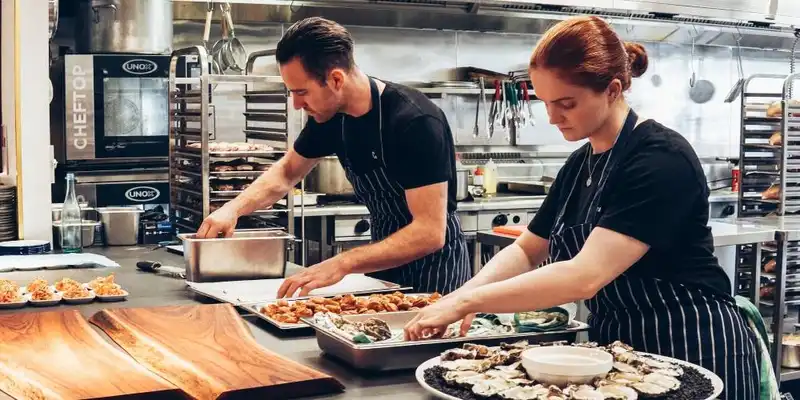Why You Need to be Using a Scheduling App in Your Restaurant
Running the Business
Running a business is certainly not an easy job. For some, operating a restaurant simply consists of preparing dishes and then serving those dishes to customers.
Whether it's a pop-up eatery, cafe, fast food restaurant, or a diner, the challenges and pressures faced in-house are relatable to all restaurateurs. The food industry is a fast-moving market and trying to keep up can prove to be quite challenging.
The industry can be highly unpredictable because there is no assurance that customers will keep coming back.
The key factors that contribute to customer loyalty are based on two important elements the quality of products and customer service.
Your recipes obviously affect success, but an area where many owners misstep is when it comes to customer service. In order to provide an excellent experience, you need to ensure you are hiring the best employees out there, in addition to staffing shift windows effectively.
Employing individuals who possess different levels of experience in the hospitality industry typically portray strong customer service skills, and these are the types of employees you want working in your restaurant.
In order to make the most of your team's strengths and capabilities, it is important to take these factors into consideration when it comes to scheduling them on a weekly basis.
The Art of Proper Employee Scheduling

Employee scheduling is the act of establishing designated time windows for employees to work a shift and complete tasks either on a daily, weekly or monthly basis.
It's a way of maximizing time for efficiency and increased productivity. It is important because it also serves as a reminder of activities, and it is a useful tool to measure the level of work or achievement of business goals.
Managing your staff in a restaurant, from the servers, bartenders, cooks, and can be tough and incredibly time-consuming. For the restaurateur, he/she must remember that each role comes with different expectations and skillsets. That means schedules must be planned accordingly, unique to not only each position but each employee's availability, as well.
How a Scheduling App Eases the Scheduling Process
Restaurant owners and managers spend valuable time trying to prepare the timetable for work around the restaurant, in a bid to ensure smooth running of the business.
In this fast-paced world of today, a good number of software applications can assist in the planning of staff schedules and responsibilities. The best type of applications should bring forth an array of benefits. Of the most rewarding deliverables, here are the key benefits that should not be overlooked when shopping around for scheduling software
1. Pro-Active
Promote forward-thinking progress and allows you to prepare in advance. Time is money; the more a restaurateur has of it, the better. The time that is saved from using a schedule maker leaves extra time for you to boost business growth.
Automated scheduling helps set activities and working times easily and quickly, as well as remind employees of shift times and tasks for the day.
Staff scheduling apps can efficiently schedule employees days, weeks, and months in advance, ensuring the restaurant is fully covered for each shift. Another great feature is how the software can also conveniently save schedules from week to week, so they can be recycled in the future, freeing up more of management's time.
Because these schedules are prepared in advance, employees also have the opportunity to find shift replacements, should they find that they cannot commit to an upcoming shift. This instills responsibility in your employees, as well as accountability.
2. Eliminates Bias
It's not uncommon for managers to develop favoritism for certain employees. This could be based on a specific employee's work ethic or punctuality. Whatever the reason, favoritism can be witnessed in how some employees being scheduled more hours or better hours over other employees.
Yes, good work warrants high reward, but it's vital to approach this with delicacy.
Staff scheduling app allows for the activities to be spread around for everybody on duty without special preferences to certain people. This helps maintain a healthy workplace relationship because it randomly selects and spread the tasks for all the staff in a particular department in your restaurant.
With that being said, you should still distribute shifts according to each employee's strengths.
You can also document employees' performances in the application. For example, if an employee shows consistent patters in tardiness, and you want to limit the amount of shifts given, you can reference back to the days said employee showed up late when explaining why that employee is not receiving as many shifts.

3. Availability
Scheduling is made useful and beneficial if there are people physically present to the work. A staff scheduling app can better manage staff with features that can track availability for previous tasks, thus creating schedules for individual staff members based on their availability.
Availability can be reviewed by the restaurateur, which will efficiently and adequately eliminate conflict when it comes to scheduling. This will also prevent employees from being scheduled for times in which they are unavailable.
4. Data Storage
A staff scheduling app allows activities and duties to be automatically assigned and tracked.
The tending of tables by staff can be revisited when needed or required. The staff scheduling app has a unique feature of data management which involves it saving activities done in the past and to be accessed when needed.
This helps to efficiently review the activities of employees in order to monitor the productivity of staff
5. Accessibility
Scheduling software makes the schedules that were created easily accessible to each member on the team. The schedule can be accessed from a smartphone, desktop/computer, or even a tablet.
Human Resources unit or team can know the work-log of each employee. Staff scheduling app makes schedules readily available and centered around decision-making for overall business growth.
















































































